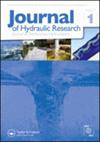引用本文:魏王儒,邓军,徐伟林,等。自由地表隧道流需气量的数值研究[j] .水利学报,2013,59(1),158—165,https://doi.org/10.1080/00221686.2020.1744747
IF 1.7
3区 工程技术
Q3 ENGINEERING, CIVIL
引用次数: 1
摘要
在数值模拟结果的基础上,考虑水流速度和水面以上隧道剩余截面积的影响,建立了新的设计方程。讨论者承认提出的方法,但也表达了他们对以下几点的担忧:(i)数值模型的验证是肤浅的,因为它只基于体积参数,忽略了已知的模型限制;(ii)数值模型没有考虑通风口特性的影响,因此在提出的设计方法中也没有考虑;(iii)作者的方法未考虑夹带空气,但对于高于6的弗劳德数可能很重要;及(iv)设计方程式的一般适用性,因为所考虑的弗劳德数范围小,而通风口特性被忽略,而通风口特性已显示对出口隧道的空气需求有重大影响。本讨论旨在澄清一些作者没有明确提出的事实,并确定作者设计方程的局限性。总的来说,我们强调,该方法描述的是不受限制的空气排放,应限于其推导所考虑的参数范围和假设,即大排气参数(A* > 0.1)和弗劳德数低于10的流动。本文章由计算机程序翻译,如有差异,请以英文原文为准。
Numerical investigation of air demand by the free surface tunnel flows By WANGRU WEI, JUN DENG and WEILIN XU, J. Hydraulic Res. 59(1), 2021, 158--165, https://doi.org/10.1080/00221686.2020.1744747
The authors developed a novel design equation based on numerical model results by taking into account the effects of water velocity and residual tunnel cross-sectional area above the water surface. The discussers acknowledge the presented approach, but also express their concerns regarding the following points: (i) the validation of the numerical model is superficial as it is based on bulk parameters only and ignores known model limitations; (ii) effects of the air vent characteristics are not considered in the numerical model and consequently neither in the presented design approach; (iii) air entrainment is not considered in the authors' approach but may be important for Froude numbers above 6; and (iv) the general applicability of the design equation due to the small range of considered Froude numbers and the negligence of air vent characteristics which have been shown to significantly impact air demand in outlet tunnels. This discussion aims at clarifying some facts not clearly presented by the authors and identifying limitations of the authors' design equation. Overall, we highlight that the approach describes the unrestricted air discharge and should be limited to the parameter range and assumptions considered for its derivation, i.e. for large air vent parameters (A* > 0.1) and flows with Froude numbers below 10.
求助全文
通过发布文献求助,成功后即可免费获取论文全文。
去求助
来源期刊

Journal of Hydraulic Research
工程技术-工程:土木
CiteScore
4.90
自引率
4.30%
发文量
55
审稿时长
6.6 months
期刊介绍:
The Journal of Hydraulic Research (JHR) is the flagship journal of the International Association for Hydro-Environment Engineering and Research (IAHR). It publishes research papers in theoretical, experimental and computational hydraulics and fluid mechanics, particularly relating to rivers, lakes, estuaries, coasts, constructed waterways, and some internal flows such as pipe flows. To reflect current tendencies in water research, outcomes of interdisciplinary hydro-environment studies with a strong fluid mechanical component are especially invited. Although the preference is given to the fundamental issues, the papers focusing on important unconventional or emerging applications of broad interest are also welcome.
 求助内容:
求助内容: 应助结果提醒方式:
应助结果提醒方式:


